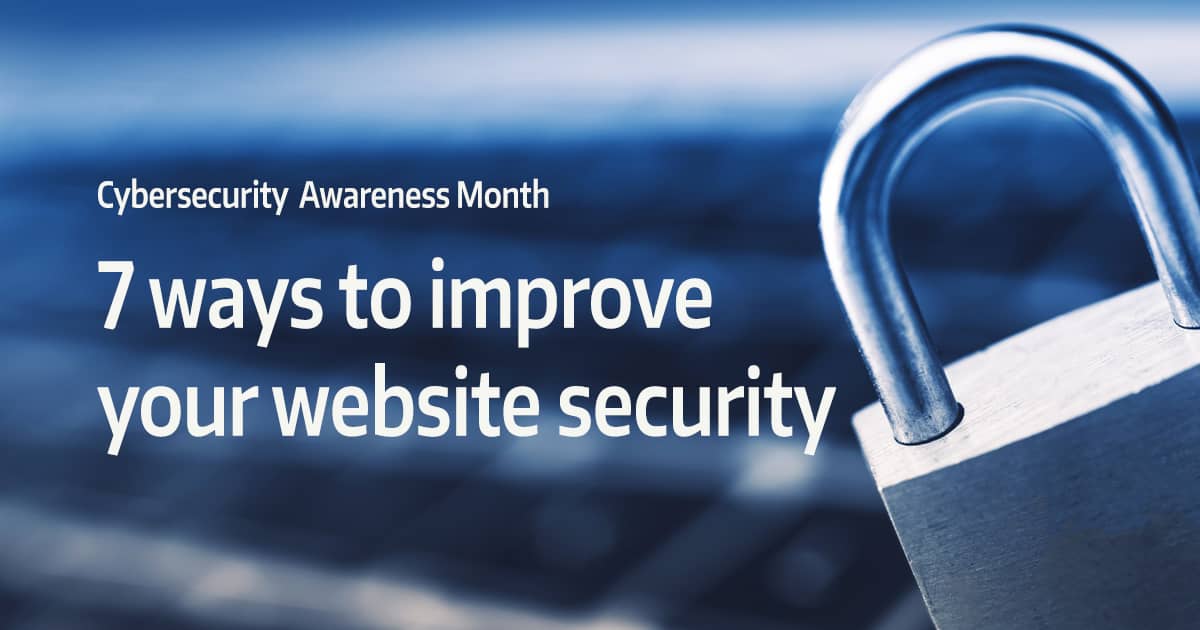
October is cybersecurity awareness month, making it the perfect time for a security check-up for your website. Sometimes the best methods for keeping your site safe are the simplest ones. Following some basic best practices can help safeguard your website right now.
Improve your website security today with these seven tips

1. Use Strong Passwords
It’s important that you use strong passwords for your website. Hackers have a variety of tools for cracking passwords. In order to protect against these attacks, you and your team should have a password policy for your organization. Each team member should use a strong, individual password when accessing and updating your website. What is a strong password? A strong password will generally include both uppercase and lowercase letters, numbers and special characters. Longer passwords also tend to be more secure.
Remembering complex passwords can be challenging. There are several secure password management services available which can help you keep track of your passwords while maintaining security. Consider using a password manager to generate, store, and secure your passwords.
2. Keep software up-to-date
Make sure you keep all platforms, scripts, and plugins you’ve installed on your website up-to-date. Outdated software security flaws are consistently targeted by hackers. If you aren’t keeping your software and programs updated, your website could be vulnerable to these attacks. Platforms, software and plugins are continuously updated to patch security holes and these patches are released as updates. Make sure installing these updates are part of your regular website maintenance in order to maintain your sites’ security.


3. Backup your website
You should back up your site regularly and maintain back up website files. If your site is compromised or data is lost you can restore from your backup files. There are automated plugins and extensions that can automatically back up your site, or you can manually create backups depending on your needs.
4. Secure your URL
Adding HTTPS protocol and installing an SSL Certificate will help protect information shared on your site. In addition to protecting customer information, an SSL Certificate will help you avoid Google’s unsafe website warning which can negatively affect your SEO.
When browsing the internet, you may have noticed a lock icon next to the url of a lot of websites. That lock shows up when sites are using HTTPS protocol and helps reassure visitors that the site they’re visiting is secure and trustworthy. Sites the don’t use HTTPS protocol have a “Not Secure” icon that appears next to the url.
An SSL certificate is an extra layer of security for your site, and may be required depending on the information you are gathering on your website. An SSL certificate is required for websites where users are submitting sensitive information like credit card numbers. While it may not be required for your site, adding an SSL certificate is a great way to increase the security of your website with an added layer of encryption.


5. Use a secure host
Using a secure hosting company can help make your site more secure. A secure host will offer security measures like a firewall, SSL certificates, remote backup and network monitoring. The hosting company’s security practices will help protect your site against cyber-attacks, so selecting a secure host is a good investment in the security of your site.
6. Scan your website for vulnerabilities
Running a security scan on your site for malware and security vulnerabilities is vital to maintaining a secure website. A website security audit can check your site for errors, malware, blacklists, and other security vulnerabilities. If any issues are identified, make sure you are proactive about updates and fixes to stay ahead of any potential cyber-attacks.


7. Use multi-factor authentication
Consider using multi-factor authentication (MFA) when possible. Multi-factor authentication requires a combination of two or more elements to authenticate yourself. You may already be familiar with this authentication method on sites that require your password and a code sent to your email or smartphone in order to log in. This is sometimes referred to as two factor authentication (2FA).
Using multi-factor authentication adds a layer of protection from all kinds of cyber-attacks. By requiring an additional point of authentication, even if a password is compromised your website can remain secure.
Conclusion
It’s important to keep your website secure.
There are easy steps you can take today to make your website less vulnerable to cyber-attacks. By following these best practices, you can help protect your website and your business.
Need help putting these steps into action? Robintek can help you improve your website security today. Contact us for a free consultation.







